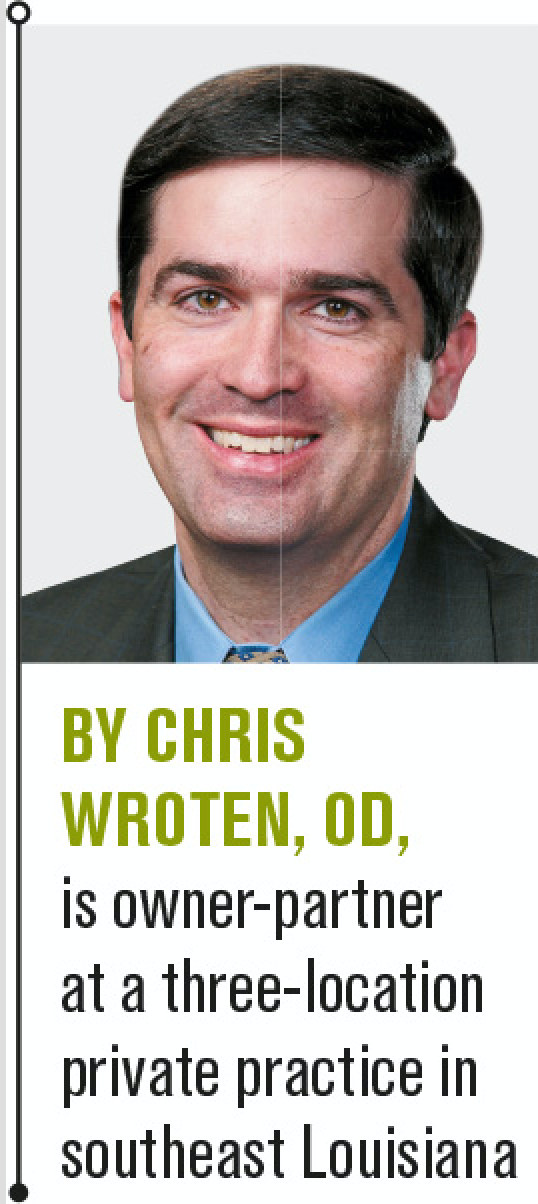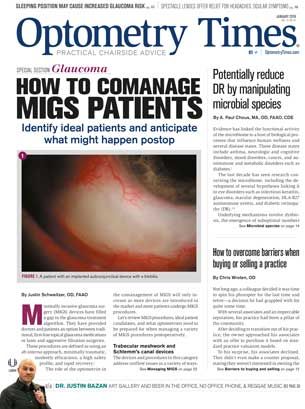How to overcome barriers when buying or selling a practice


Not long ago, a colleague decided it was time to spin his phoropter for the last time-a decision he had grappled with for quite a while.
With several associates and an impeccable reputation, his practice had been a pillar of the community.
After finally deciding to transition out of his practice, the owner approached his associates with an offer to purchase it based on standard practice valuation models.
To his surprise, his associates declined. They didn’t even make a counter proposal, stating they weren’t interested in owning the practice because they didn’t see any value in it.
He was then faced with a huge dilemma: Now finally ready to retire, how was he going to make it happen?
Sale management
One of the most important but overlooked aspects of practice management is managing the sale of a practice on the back end of a career.
While each situation is unique, more optometrists are struggling with the same question: “How do I transition out of my practice?”
Previously by Dr. Wroten: How to know if a professional employer organization can help you
The answer for an alarming number of ODs has been to simply lock their doors and walk away, receiving nothing in return for the equity they have built in their practices.
This problem is not unique to optometry- medicine and other healthcare professions are experiencing the same phenomenon.
The situation then begs the question: Is the traditional transaction of transferring private practice ownership to a new owner in danger of extinction?
Planning ahead
Meanwhile, other eyecare professionals are asking, “How do I transition into practice ownership?”
With many optometry school graduates expressing a desire to enter private practice yet ultimately choosing other alternatives, why is there this disconnect?
And more importantly, how can these inter-related problems of owners failing to transition their practices-and private practice opportunity seekers failing to make their wishes come true-be remedied?
Related: How to calculate the value of your practice
The old mantra is never truer than when it comes to practice transitions: Failing to plan is planning to fail.
Because it typically takes several years for a successful practice transition to come to fruition, the time is now to start planning your next move, either as the purchaser or as the seller.
But to use another cliché, the devil is in the details. So how do we successfully transition a practice, either as the seller or as the purchaser?
Barriers
Whether a new graduate or an established practitioner seeking to change his situation, the potential buyer often faces several challenges, which are important for both parties to understand. Some common barriers to acquiring a practice include:
• Misunderstanding ownership benefits/responsibilities
• Student loan debt
• Realistic expectations
• Identifying opportunities
Having worked as an associate in a private practice, as an independent contractor in a commercial setting, and now as a private practice owner, I have an appreciation for the risks and benefits of employment, as well as ownership.
Read more about practice management
Misunderstanding ownership
For me, the satisfaction that comes from being directly involved in decision-making and seeing our practice succeed, the job security and independence it offers, as well as the reimbursement and equity that’s built over time, far outweigh the commitment and responsibility required versus being an employee.
But some doctors may prefer the employment option, leaving the decision-making, hassles and extra commitments of ownership to others.
It’s critical to respect both groups, but it’s also important to ensure potential buyers understand the benefits and responsibilities of ownership.
For doctors who have never been owners and may not have a grasp of that knowledge, the responsibility to educate potential buyers in this area may fall on the seller.
Student debt
An additional concern is the increasing number of optometry school graduates entering the profession with student debt in excess of $200,000, which mirrors the average medical school graduate’s indebtedness of $190,694.1
This financial burden can overwhelm young doctors and lead them to unnecessarily limit their career choices to opportunities that may deceptively appear to be the best option due to higher starting salaries.
Helping these doctors understand the potential long-term rewards of practice ownership-not to mention understanding their student loan repayment and refinancing options-can significantly increase the pool of prospective participants in practice transactions.
The American Optometric Association’s (AOA) Excel program offers consulting services in practice transitions and personal finance, as well as student loan refinancing services, at significant discounts for its members through Williams Consulting and Laurel Road Student Loan Refinancing, respectively.2
Helping prospective doctors understand they can make a practice purchase work from a financial perspective is huge.
Related: Debt management tips for ODs
The practice itself can even help subsidize or refinance student loans for potential practice purchasers while also realizing tax savings in certain situations.
Seek the advice of a certified public accountant (CPA), financial advisor, and/or a practice management consultant to learn more.
Realistic expectations
Unrealistic expectations are another common problem the practice transition faces. Both parties can be guilty of unrealistic expectations, but today let’s focus on potential purchasers.
Many new graduates seem closed to rural practice settings, only willing to contemplate only large urban areas. As a result, some established practices in rural areas are dying on the vine.
Potential purchases are missing opportunities by not considering the expanded scope of practice, enhanced earning potential, lower cost of doing business/living, and the potential for a higher social status that rural areas can offer.
Many of these rural practices are just a relatively short distance from major metropolitan areas, allowing an OD to live in the larger city nearby with a reasonable commute to the office.
ODs who are selling should consider asking their nearest school/college of optometry to guest lecture to its practice management classes on the benefits of their particular practice setting with the goal of increasing their pool of suitors.
Additionally, a potential buyer’s expectations on starting salary and benefits must be tempered with the understanding that-depending on the transaction desired-the starting salary may initially be lower than as a contractor in a commercial setting or as an employee in an ophthalmology practice.
However, the job satisfaction and financial reward in the long run can be greater as equity accrues in the practice, equipment, and associated building and land.
Resources to consider
Even when these barriers are overcome, many purchasers still struggle to find opportunities. Several great resources can help them connect with sellers:
• Job boards such as Optometry’s Career Center3 and state optometry associations’ websites, most of which allow ODs to post their curriculum vitae at no cost
• Optometry school faculty and state association executive directors, who can be a wealth of knowledge regarding discreet opportunities
• Networking at local/state/regional/national optometry meetings
• Direct recruitment
These tasks may appear daunting, especially to a purchaser, but these barriers can be overcome, resulting in life-changing opportunities for all involved-so start planning now.
References:
1. Rathmanner D. Student loan repayment strategies for medical professionals. Student Doctor Network. Available at: https://www.studentdoctor.net/2018/04/10/student-loan-repayment-strategies/. Accessed 12/4/18.
2. American Optometric Association. Solutions for all your business, career or student needs. Available at https://www.aoa.org/aoaexcel. Accessed 12/4/18.

Newsletter
Want more insights like this? Subscribe to Optometry Times and get clinical pearls and practice tips delivered straight to your inbox.